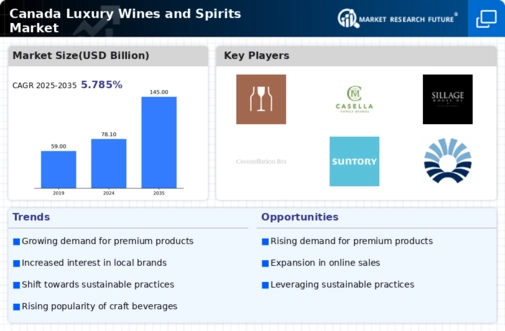Increased Global Tourism
The resurgence of global tourism is a notable driver for the Global Canada Luxury Wines and Spirits Market Industry. As international travel resumes, Canadian wineries and distilleries are witnessing a surge in visitors eager to experience local luxury offerings. This influx of tourists not only boosts sales but also enhances brand visibility on a global scale. In 2024, the market is expected to reach 3500 USD Million, largely fueled by this renewed interest in experiential travel. Tourists often seek unique local products, thereby creating opportunities for Canadian luxury wine and spirit producers to expand their market reach and cater to a diverse clientele.
Market Growth Projections
Market growth projections for the Global Canada Luxury Wines and Spirits Market Industry indicate a promising trajectory. The market is set to expand from 3500 USD Million in 2024 to an anticipated 5500 USD Million by 2035. This growth reflects a compound annual growth rate of 4.19% from 2025 to 2035, highlighting the increasing consumer interest in luxury beverages. Factors contributing to this growth include rising disposable incomes, evolving consumer preferences, and enhanced marketing strategies. The positive outlook suggests that the industry is well-positioned to capitalize on these trends, potentially leading to further innovations and product diversification.
Evolving Consumer Preferences
Shifts in consumer preferences towards premium and organic products significantly influence the Global Canada Luxury Wines and Spirits Market Industry. Today's consumers are more discerning, often favoring quality over quantity. This trend is evident in the rising popularity of organic wines and craft spirits, which are perceived as healthier and more authentic. The market is adapting to these preferences, with producers increasingly focusing on sustainable practices and unique flavor profiles. As a result, the industry is likely to experience a compound annual growth rate of 4.19% from 2025 to 2035, indicating a robust response to evolving consumer demands for luxury products.
Growing Affluence of Consumers
The increasing affluence of consumers in Canada is a pivotal driver for the Global Canada Luxury Wines and Spirits Market Industry. As disposable incomes rise, more individuals are willing to invest in premium products, including luxury wines and spirits. This trend is particularly evident among millennials and Gen Z consumers, who are increasingly seeking high-quality, artisanal beverages. The market is projected to reach 3500 USD Million in 2024, reflecting a growing demand for luxury offerings. This demographic shift indicates a potential for sustained growth, as affluent consumers prioritize unique experiences and premium products, thereby enhancing the overall market landscape.
Innovative Marketing Strategies
Innovative marketing strategies are transforming the Global Canada Luxury Wines and Spirits Market Industry. Producers are increasingly leveraging digital platforms and social media to engage consumers and promote their brands. By utilizing targeted advertising and influencer partnerships, luxury brands can effectively reach niche markets and enhance their visibility. This approach not only attracts younger consumers but also fosters brand loyalty among existing customers. As the market evolves, these strategies are likely to play a crucial role in driving growth, with projections indicating a market size of 5500 USD Million by 2035. The emphasis on digital engagement reflects a broader trend towards modernization within the industry.
Regulatory Support for Local Producers
Regulatory support for local producers is a significant factor influencing the Global Canada Luxury Wines and Spirits Market Industry. Government initiatives aimed at promoting local agriculture and artisanal production have created a favorable environment for luxury wine and spirit manufacturers. Programs that support sustainable practices and provide funding for innovation are particularly beneficial. This support not only enhances the quality of Canadian luxury products but also encourages exports, thereby expanding market opportunities. As the industry continues to grow, such regulatory frameworks are likely to contribute to the projected market expansion, with a compound annual growth rate of 4.19% anticipated from 2025 to 2035.



















Leave a Comment